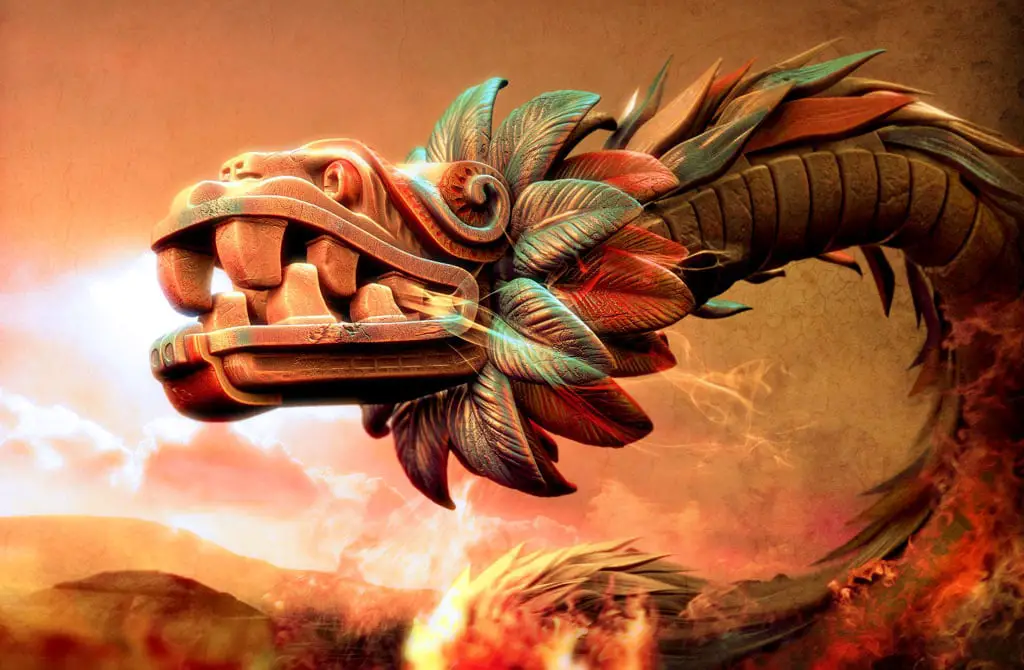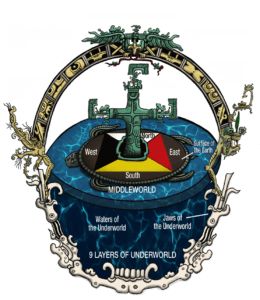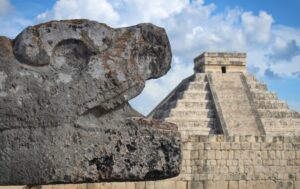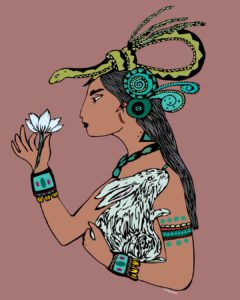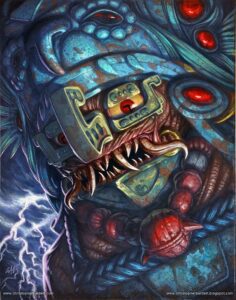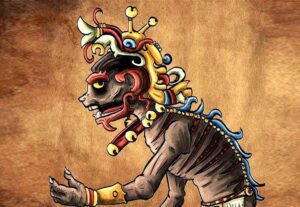MAYAN GODS AND GODDESSES
The cultural richness found in Riviera Maya and the Yucatan Peninsula can be found not only in our Delicious Traditional Cuisine but also in the huge legacy of one of the greatest civilizations of all time. Guided by many powerful and wise Gods and Goddesses, the Mayan culture left temples, ruins, and sculptures, which are just a hint of what really happened here many eons past. Join me today, my curious travelers on a journey to discover these ancient powers that fueled this magnificent civilization.
THE MAYAN COSMOS
In ancient times, religion was mankind’s way of relating with the cosmos to maintain the natural balance of life. Particularly in the Mayan culture, the gods were seen as divine energies capable of presenting themselves in earthly reality as humanoids, animals, plants, and/or a combination of them. The image of many of the Mayan gods has been discovered in rich artistic expressions, mainly in architecture, paintings, sculptures, and on the few ancient codices left after the destruction of many others by the Spaniards who wanted to bury the secrets of this amazing civilization.
The Mayans believed the cosmos was divided into 13 heavens or “upper worlds”, each ruled by an Oxlahuntikú, sometimes considered a single deity or thirteen separate gods. On the other hand, Xibalbá, the Mayan Underworld was divided into 9 levels where the Bolontikú, the Lords of the Night, resided in each level. At the center of the Mayan world was the Yaxché, a sacred ceiba tree that had given sustenance to the first men and whose branches reached up to the heavens, and whose roots penetrated the underworld. Finally, the whole Mayan heaven was supported by four “carrier” gods, the Bacabés, related to the four cardinal points.
source: jaguarstones.com
The Mayan gods were part of a complicated and diverse vision of the Mayan people, they had different physical attributes and they even had different names depending on the place and time in which they were found or needed, for example, it was more important to worship a god related to rain in dry places than where it rained abundantly. Among the 250 Mayan Gods, sometimes it can become difficult to identify the most important, mainly because many had dual characteristics such as human – animal, old – young, man – woman. So for now let’s talk about some of them that are still worshiped around the Riviera Maya and the Yuacatan Peninsula.
KUKULCÁN “The Feathered Serpent God”
K´u´uk´ul Kaan is what he is called in the Yucatecan Mayan world, but he is known by different names depending on the time and civilizations that venerated him, in Maya Quiché he’s called Gucumatz (Q’uk’umatz). Although he was present in various pre-Columbian civilizations like de Aztecs and Teotihuacan, it all began in the Olmec world, under the name Quetzalcóatl, meaning “the Feathered Serpent”.
In some legends, Kukulcán is portrayed as a man who came from the far West to teach agriculture, worship, politics, science, and the arts. However, the people of the West suggest that he came from the center of the country. In any case, it’s important to consider that the West is also the cardinal point where the ancient Mayans believed that they entered or left the underworld, the place where the deities inhabit.
In Mayan mythology, Kukulcán is one of the creator gods and giver of wisdom and intelligence to humanity, the God of water, winds, and storms dominating the four elements.
As an important agricultural society, the weather and the seasons were essential parts of their survival, so Mayan civilization managed to record the variations in the trajectory of the Sun and the stars as observed on Chichén Itzá, standing out for being a culmination of the astronomical, mathematical, geometric and acoustic knowledge of the time. Kukulcán’s presence is revered especially during the beginning of the agricultural cycle, every autumn and spring equinox, when sunset arrives, a shadow of seven triangles that make up the body of a snake is observed on the steps of the Kukulcán pyramid descending from the top of the pyramid, the last breath of light being in the head of the animal, right at the base of the temple. I don’t know what you think about this, but it seems to me that the Mayans invented light mapping.
Shaped like a snake with long and iridescent quetzal feathers, He could move agilely on land and water and his feathers allowed him to fly, it is said that he helped the god Chaac by flying in front of him to clean the clouds and the paths of the sky with his feathered tail. Kukulcán was a kind of hero-civilizer who brought religion, and writing and even taught communities about war.
Although it is believed Kukulcán founded the city of Mayapán, considered the last great capital of the ancient Mayan civilization, he left back to his place of origin and disappeared, but His return to the Mayab is prophesied and we are still waiting for Kukulcán to come back, anytime now.
Photo by Jeison Higuita
IX CHEL “The Moon Goddess”
Ix Chel is an important goddess of the Mayan pantheon, mainly associated with lunar cycles, fertility, and keeper of pregnant women, midwives, and healers, as with other aspects of medicine still practiced in the Yucatan region. She was related to different artistic expressions such as the creation of textiles, painting, singing, and dancing.
Several names and representations are known for Ix Chel according to each situation. Often represented as a beautiful young maiden accompanied by a rabbit, as a symbol of the crescent moon or weaving with a waist loom she built, therefore associated with the spider, her weaving symbolized the umbilical thread, the thread of life.
In contrast to her other gifts, the Lady of the Rainbow, was also believed to represent water in its most destructive form, causing storms, curses, and devastation on Earth. As an old crone or the waning moon, Ix Chel was represented surrounded by symbols of Xibalbá like skulls or crossed bones on its skirt, as well as a snake wrapped around her neck coming out of her head and claws as feet.
Every year the goddess Ix Chel is still celebrated at the Riviera Maya in an event where people cross in canoes from Xcaret, to one of the most important temples dedicated to this goddess located in Cozumel. On the other side, at the southern tip of Isla Mujeres, there is a temple dedicated to Ix Chel, where ancient Mayan women will leave clay sculptures of the goddess as an offering and prayer for a child.
Hand-drawn and colorized digitally by Arely Camacho}
She was married to another important god, Itzamná “The Ruler of Heaven, Day, and Night” Mayan Legends say that he was first a wanderer priest who came along with the Chanes of Bacalar to found and settled in what is now known as Chichén Itzá and later was elevated to a deity for all that he contributed to the Mayan culture. He was seen as the Mayan deity who symbolized the energy that created water, He was credited with the invention of writing and the calendar. Itzamná was also in charge of protecting astrology, medicine, and agriculture. He is considered the universal spirit of life that encourages chaos so that there can be creation.
They had children, some of whom were also Gods and creators of Earth, one of them was Yum K’aax “The God of Corn”, his name comes from the words Yum/lord and Kaax/forest, so he was literally “The Lord of the Forest”. Yum K’aax was in charge of agriculture, the abundance of life and prosperity, sculptures and codices show him engaged in a wide variety of agricultural jobs, controlling the food of the Mayans, mainly the sacred corn.
CHAAC “The God of Rain and Thunder”
Warrior and protector of agriculture, Chaak was in charge of bringing rain to help farmers with their crops to achieve a productive and abundant harvest. whenever Mayans would find themselves with drought issues, they would worship him and perform ceremonies still practiced among Mayan communities to this day, called the “Ceremony of Abundance” which takes place from March to May.
Taking into consideration the time when Chaak representations began to appear in buildings and sculptures, it is likely that He was introduced by the Mexicas or Toltec culture, reaching a big influence due to the absence of large river sources in the north of the Yucatan Peninsula and during a long period of rain drought along the Puuc Route. As Chaak is related to water, he lived in caves and cenotes, which were also the entrance to the Mayan underworld.
In Maya art, Chaac can be identified by a long nose and backward-curved fangs protruding from his mouth as well as a headdress made of cloth and wood, and carried an ax that represents lightning. Even in some archaeological zones of the Yucatan Peninsula, such as Kaaba, Uxmal and Chichen Itza, you can find structures beautifully decorated with masks of this god also represented as an old man with an appearance similar to an amphibian or reptile. Like other Mayan gods, Chaak is not considered a single deity, it was also represented by 4 gods. Each one was a lord of a cardinal point and was represented by different colors and birds.
YUM KIMIL “Lord of the Dead”
King and lord of the ninth and most sinister level of Xibalbá, husband of the goddess Xtabay, who protected those who had committed suicide. In the Mayan codices, Yum Kimil was represented with a skull for a head, showing bare ribs and projections of the spine, some parts of its skeletal body were covered in meat with black circles as signs of putrefaction, he also appears to emanate fetid gases from the nose or anus and completed with necklaces, bracelets and jingle bells made of copper and gold, as symbol of his victims. His figure is sometimes accompanied by a dog or an owl, considered as creatures of bad omen and death or covered in a rope that represents his power to take life away. To calm the fury of Kisin, the Flatulent God, Mayans used to make human and animal sacrifices to the beat of dancing and singing, although these celebrations were held with the purpose of warding off death, favors could also be asked of him, such as courage for an upcoming war. It is believed that Ah Puch may be androgynous because it has been found represented in ritual and daily activities carried out by both sexes such as smoking tobacco, witnessing sacrifices, and making textiles on a waist loom.
It was said that the sick died because Yum Kimil absorbed their energy and in the modern Maya communities is still believed that Yum Kimil prowls around the rooms of the sick, stalking for his next prey.
Source: postposmo.com
Uncovering the secrets behind the Mayan civilization and their religion is an important part of our Mexican Culture, secrets we are happy to share with curious adventurers and foodies, just like you.
Yuum Bo’otik (Thank you)
-Abbey

